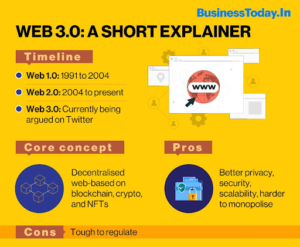In news– The concept of Web3, also called Web 3.0, used to describe a potential next phase of the internet, created quite a buzz in 2021.
What is Web 3.0?
- It is a decentralized internet to be run on blockchain technology, which would be different from the versions in use, Web 1.0 and Web 2.0.
- In Web3, users will have ownership stakes in platforms and applications unlike now where tech giants control the platforms.

- Currently if a seller has to make a business to the buyer, both the buyer and seller need to be registered on a “shop” or “platform” like Amazon or Ebay or any such e-commerce portal.
- What this “platform” currently does is that it authenticates that the buyer and seller are genuine parties for the transaction.
- Web3 tries to remove the role of the “platform”.
- For the buyer to be authenticated, the usual proofs aided by block chain technology will be used.
- The same goes for the seller and with block chain, the time and place of transaction are recorded permanently.
- Thus, Web3 enables peer to peer (seller to buyer) transactions by eliminating the role of the intermediary.
- The spirit of Web3 is Decentralized Autonomous Organization (DAO) which is that all the business rules and governing rules in any transaction are transparently available for anyone to see and software will be written conforming to these rules.
About Web 1.0 and 2.0-
- Web 1.0 is the World Wide Web or the internet that was invented in 1989.
- The internet in the Web 1.0 days was mostly static web pages where users would go to a website and then read and interact with the static information.
- Even though there were e-commerce websites in the initial days it was still a closed environment and the users themselves could not create any content or post reviews on the internet.
- Web 1.0 lasted until 1999.
- Web 2.0 started in some form in the late 1990s itself though 2004 was when most of its features were fully available.
- It is still the age of Web 2.0 now.
- The differentiating characteristic of Web 2.0 compared to Web1.0 is that users can create content.
- They can interact and contribute in the form of comments, registering likes, sharing and uploading their photos or videos and perform other such activities.
- Primarily, a social media kind of interaction is the differentiating trait of Web 2.0.
















